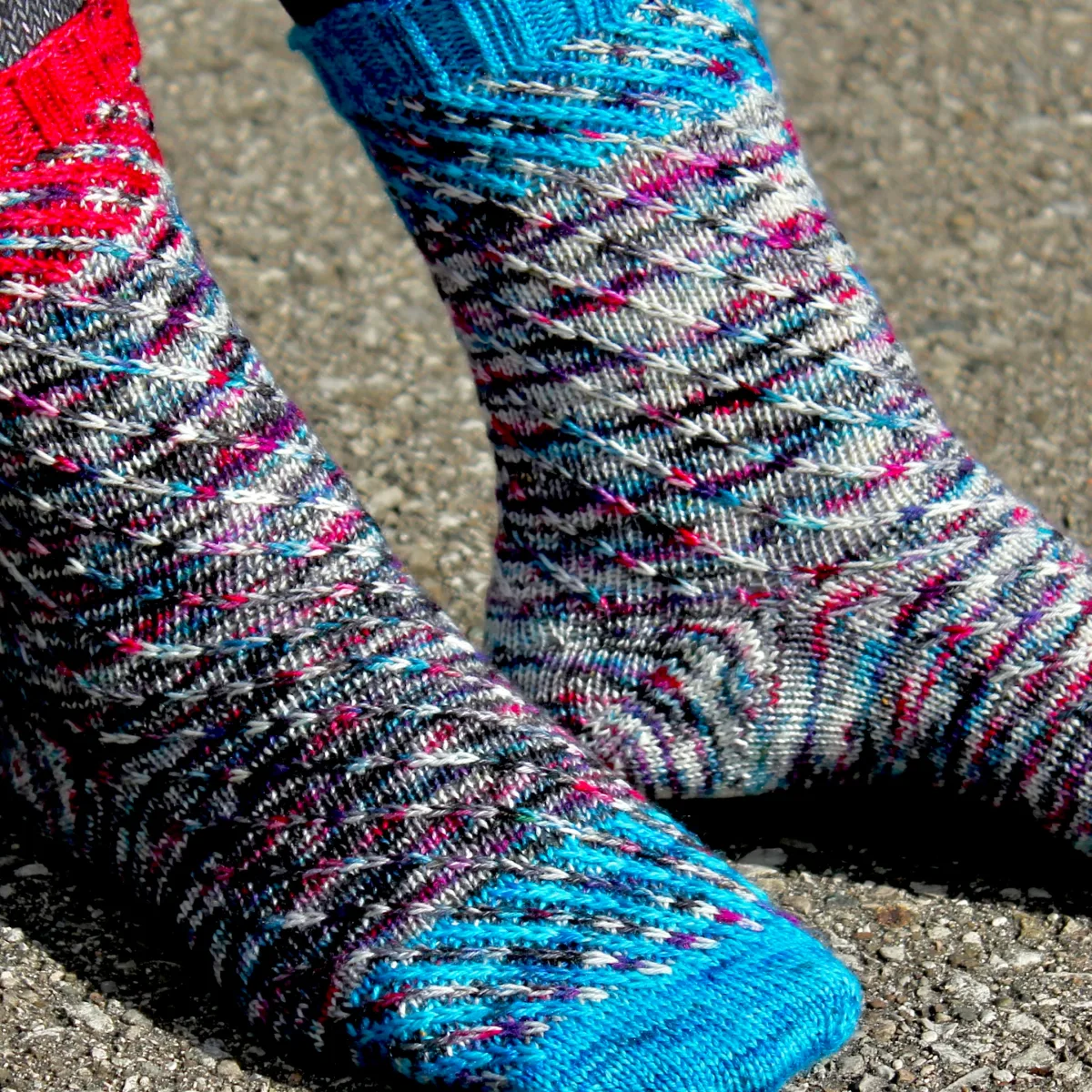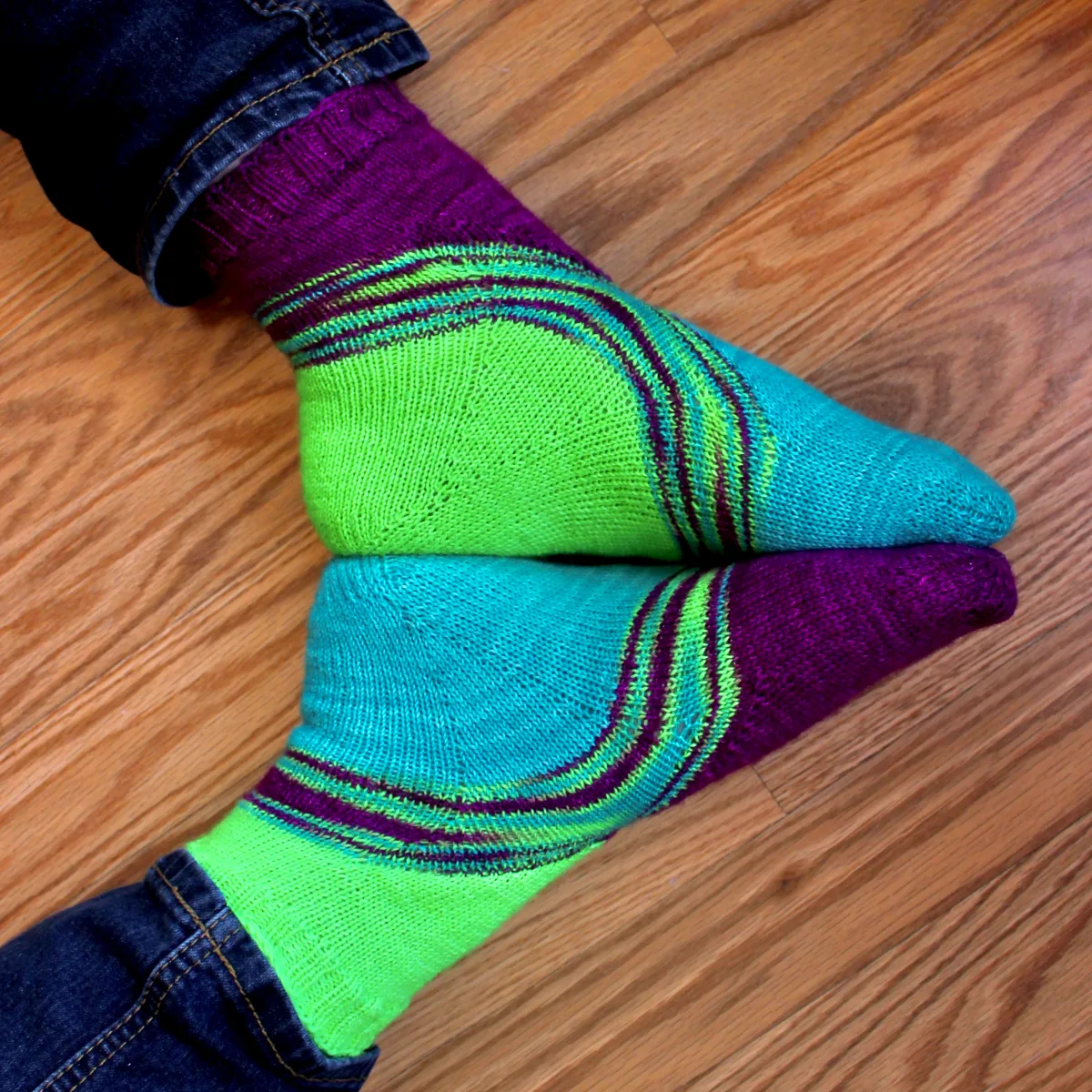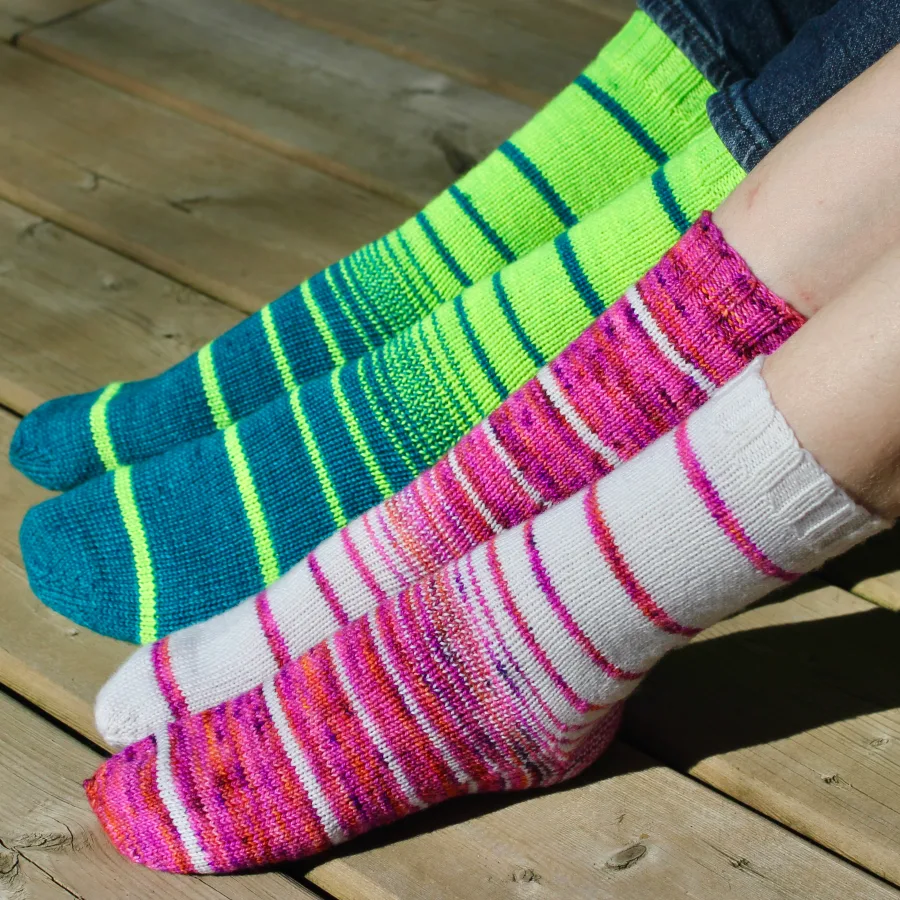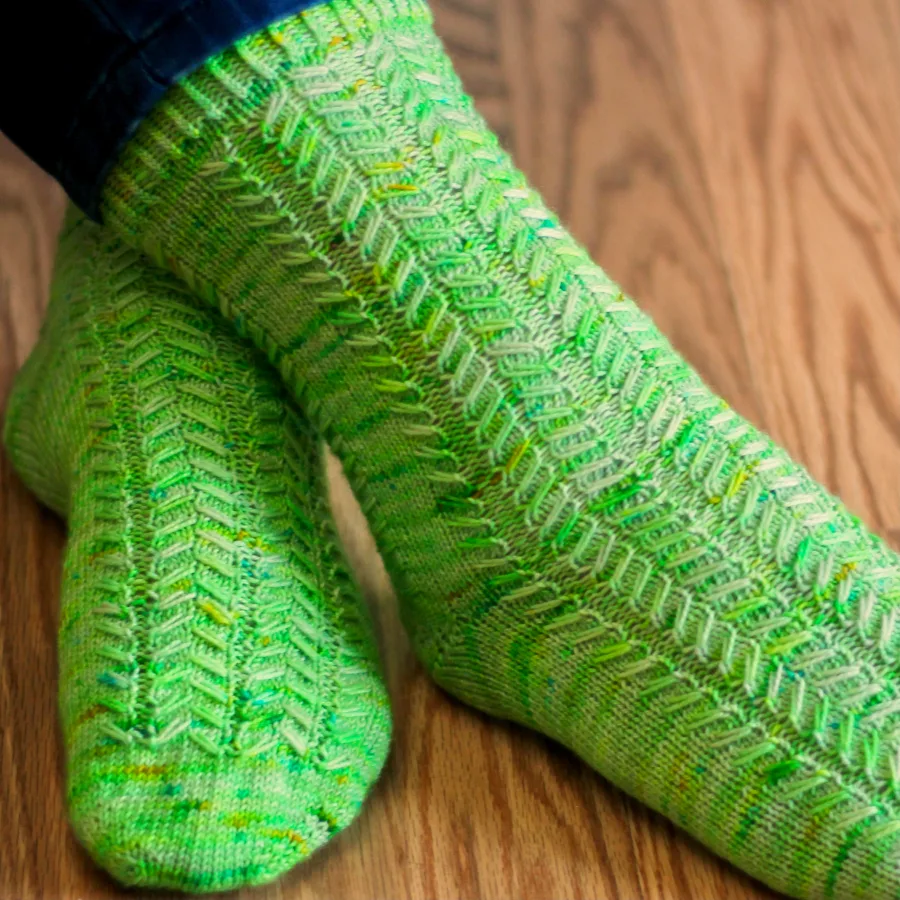How To Choose The Best Circular Knitting Technique For Any Sock Pattern

As a sock designer, I see a lot of experienced sock knitters get "married" to a particular sock knitting technique and never make socks any other way. Sometimes this works just fine for them, if the technique is flexible enough to work with most patterns. But often, it would make knitters' experiences much better if they were comfortable with a range of techniques, so that they can choose one that works best for whatever pattern they might like to make without unnecessary frustration.
What are the options for sock-knitting techniques? Well, for making one sock at a time, the most common four options are double-pointed needles, magic loop (i.e., using one circular needle with a long, flexible cord), two circular needles, and one short circular needle. For two-at-a-time sock knitting (meaning having both socks on the same needles; this is different from "tandem knitting", where each sock is on its own separate set of needles and you switch back and forth between the two), you're limited to magic loop or two circular needles (it is theoretically possible to work two-at-a-time on either longer or a larger number of DPNs, but no one actually does so, to my knowledge).
"But can't you just use whatever technique you want for any pattern?" you might ask. Well, theoretically, yes, but honestly? For some techniques the answer is no, not unless you're okay with taking a lot of breaks from knitting to rearrange your stitches and needles. I'm going to talk about each technique below — how they work, how flexible they are to accommodate different sock-knitting projects, and when they are the ideal choice and when they don't work well at all.
The Reliable Classic: Double-Pointed Needles
Here's where I admit that I love my DPNs! Despite all the hype around making socks using various kinds of circular needles, my personal favourite is still the old-fashioned rigid, pointy sticks. I love them for knitting in general and I especially love them for designing socks, and I think after reading this section, you'll see why (even if you don't feel the same way)!
How DPNs Work
When knitting with DPNs, you divide your stitches over three or four needles (usually four for socks) so that your work is roughly a triangle or diamond shape. Then you use one more DPN to work all the stitches along a given needle. When that needle is empty, it becomes the working needle and you use it to continue along to the next DPN, and so on as you work rounds.
A big advantage to this method is that it's extremely flexible. Shifting stitches between needles to organize things differently or move the beginning of the round is straightforward (often all you have to do is work a stitch or two from the next needle onto the current one before switching to a new working needle), and even using multiple needle sizes in one project (say, one for the sole and one for the instep to give you more room in a heavily-patterned sock) is very easy with DPNs. You can also use the breaks between needles to substitute for stitch markers, to keep sections of stitches very visually distinct in your project. DPNs exist in a wide range of materials (wood, metal, plastic, and even carbon fibre) and are widely available and affordable.
The main disadvantage of DPNs is that you need several of them in your project at once. This can make your knitting rhythm a bit "choppier", since you transition between needles more often than with other methods. Some people also find that their tension at needle transitions is looser, leaving a column of "ladders" that look untidy. (This issue is fixable with practice, and also by rotating the position of the DPNs around the work so the gaps aren't in the same place for too long, but the latter option does prevent you from being able to also use those needle breaks as stitch markers.) DPNs are also open at both ends, so accidentally dropping stitches or accidentally snagging stitches from the existing fabric is also something to watch for when you're new to the technique.
Choosing Sock Patterns For DPNs
If DPNs sound a bit fiddly right now, don't write them off yet! Because despite any flaws they may have, they're absolutely the most versatile sock-knitting option out there. It's easy to shift stitches around on DPNs, and this is the key characteristic that makes them work for so many different sock patterns. You can easily make patterns that are plain, patterns with a lot of design details, patterns that move the beginning of the round frequently, and patterns with all different construction styles. You can add or remove DPNs to manage narrower sections like the smallest rounds on toes and afterthought heels, or (to an extent) wider sections like the largest parts of the gussets or connecting sections in unconventional socks.
The only times when DPNs are not suitable for a sock-knitting project is if there are a lot of yarn overs at needle boundaries (though this is doable with practice and is even worse to deal with in some other sock-knitting methods, it's worth mentioning that yarn overs at the beginning or end of DPNs can be awkward, and it isn't always fixable by rotating the DPNs around the work to avoid having yarn overs at the edges of the needles), or if the way the sock is constructed reaches a point that there are so many live stitches that DPNs are impractical. If the stitches are threatening to fall off the DPNs all the time, or if the number of DPNs required to avoid having stitches fall off the needles seems excessive, another method is probably more suitable. (But notice that even then, it's always possible to use DPNs.)
Conclusion
Double-pointed needles win the award for "Most Versatile Sock-Knitting Method". No other sock-knitting method is suitable for such a broad range of patterns! It's even easy to substitute DPNs in patterns written specifically for other methods, especially magic loop and two circular needles, because "Needle 1" and "Needle 2" can easily be "Needles 1 and 2" and "Needles 3 and 4" without needing to change anything else about the instructions. If you only want to learn and use one sock-knitting method, ever, for every pattern you ever make, this should be it, because even when it's not the most ideal choice, it will still do the job for you.
The Crowd-Pleaser: Magic Loop
In my experience, the sock knitters I encounter who are the most opinionated about accommodating different sock-knitting methods in patterns are people who use the magic loop method. The most-loved technique for people who hate DPNs, this one-long-cord-circular-needle option has exploded in popularity over the past couple of decades, especially with the rise of "two-at-a-time socks on magic loop" workshops and video tutorials (more on two-at-a-time knitting later).
How Magic Loop Works
When knitting on a single long circular needle, you divide your stitches in half. One half goes on the bottom needle, and the other half is held on the cord, with a loop bent between them to keep them separated and reduce stress on the stitches at the edges of each section. The top needle is empty with more cord pulled away from the held stitches, and it is used to work the stitches on the bottom needle. Then you turn your work around and pull the cord until you again have a bottom needle with stitches on it, the other half of the stitches on the cord, and an empty top needle to knit with. (This sounds complicated, and it does have a learning curve. But there are lots of videos that show how it works and it's intuitive once you get started.)
An advantage to this method is that it's extremely compact and efficient. Even though it is more fiddly to turn a corner on magic loop than it is on DPNs, there are half as many corners to turn, so with practice magic loop can be more efficient and feel faster. Compared to DPNs, magic loop can hold way, way more stitches without any issues; in fact, in my experience, it actually works better with more stitches, meaning wide sections of sock patterns are no trouble at all. Circular needles with long cables are used for a lot of purposes besides magic loop knitting — any wide project, worked flat or in the round, uses them too in a more traditional way — so you might not even need to buy any new needles to try this method. They exist in a wide range of materials (wood, metal, plastic, and even carbon fibre) and are widely available and affordable. Quality varies, however, and it's important to note that magic loop can put a lot of strain on the cable (especially at the joins) from the tight turns.
The main disadvantage of magic loop is that (despite the bendy cord) it lacks flexibility. The two tight turns mean that those gaps are not easily available to you for working any patterning (hence why, as a designer, I don't use this method very often). Trying to work a yarn over or an increase (or, worst of all, picking up stitches) in that gap is awkward, and working multi-stitch techniques like decreases, cables, or gathered stitches (or the back-and-forth of short-row sections) over those gaps is also problematic. Don't get me wrong; you can absolutely move stitches around at the turns if you need to! Just pull the cord in to bring all the stitches together, move stitches around, and loop the cord back out. But it's not a very comfortable or convenient thing to have to do on a regular basis. Plus, magic loop puts a lot of strain on the stitches bordering the corners, and that creates some of the same "ladddering" tension issues that can arise between needles on DPNs, except on magic loop the options for eliminating those gaps are limited ("travelling loop", where the circular needle cable is pulled through different places in the work in different rounds, is probably the best option, but it is much more labour-intensive to do than rotating DPNs). You also cannot use two different needle sizes at once when working magic loop, since you're always using the same working needle for all the stitches in each round.
Choosing Sock Patterns For Magic Loop
Magic loop's ease of use depends heavily on there being a stable beginning of the round and a stable halfway point (this doesn't actually have to be literally "halfway", but it does need to be a stable point somewhere around halfway through the round). It's not very convenient to shift stitches between needles on magic loop, especially on socks because the gauge is tight and the circumference is small, so the more you need to move the two turning points (BOR and halfway) in a sock pattern, the less convenient it is to use magic loop for that pattern. Rearranging needles and stitches once or twice at key transition points (before and after the heel, for example) is not the end of the world, but it isn't a fun interruption to your knitting rhythm to deal with on a frequent basis.
How do you figure out whether a pattern is suitable for magic loop (preferably without needing to analyze the entire pattern document looking for BOR shifts)? In general, magic loop works well on the foot of the majority of sock patterns, because (by necessity) most will have some kind of clear division between the sole and the instep, and texture patterning doesn't normally travel between them. However, on the leg that might not be the case. Therefore, the leg is often the key place to look for information about whether a pattern is going to be easy to work on magic loop. If there is a clear division between the front of the leg patterning and the back of the leg patterning that is consistent, it's likely that it will work well, with a minimum of inconvenience. Continuous spirals, as well as cables, lace, or short rows that cross the halfway point, are better-suited for other sock-knitting methods, such as DPNs or short circular needles.
Conclusion
Magic loop wins the award for "Most Portable Sock-Knitting Method". With the working needle and the needle holding the next half of the stitches on the same cord, and with a long, flexible cable involved, stitches worked on magic loop are very stable and everything is attached to one thing with no loose pieces. It's so popular because it is efficient and tidy, and it offers the option to work two at a time on that same compact, easy-to-bring-along setup (more on that later!).
Ideal For Magic Loop: Stable BOR And Halfway Point

Not Ideal For Magic Loop: Spiralling Horizontal Texture Stitches
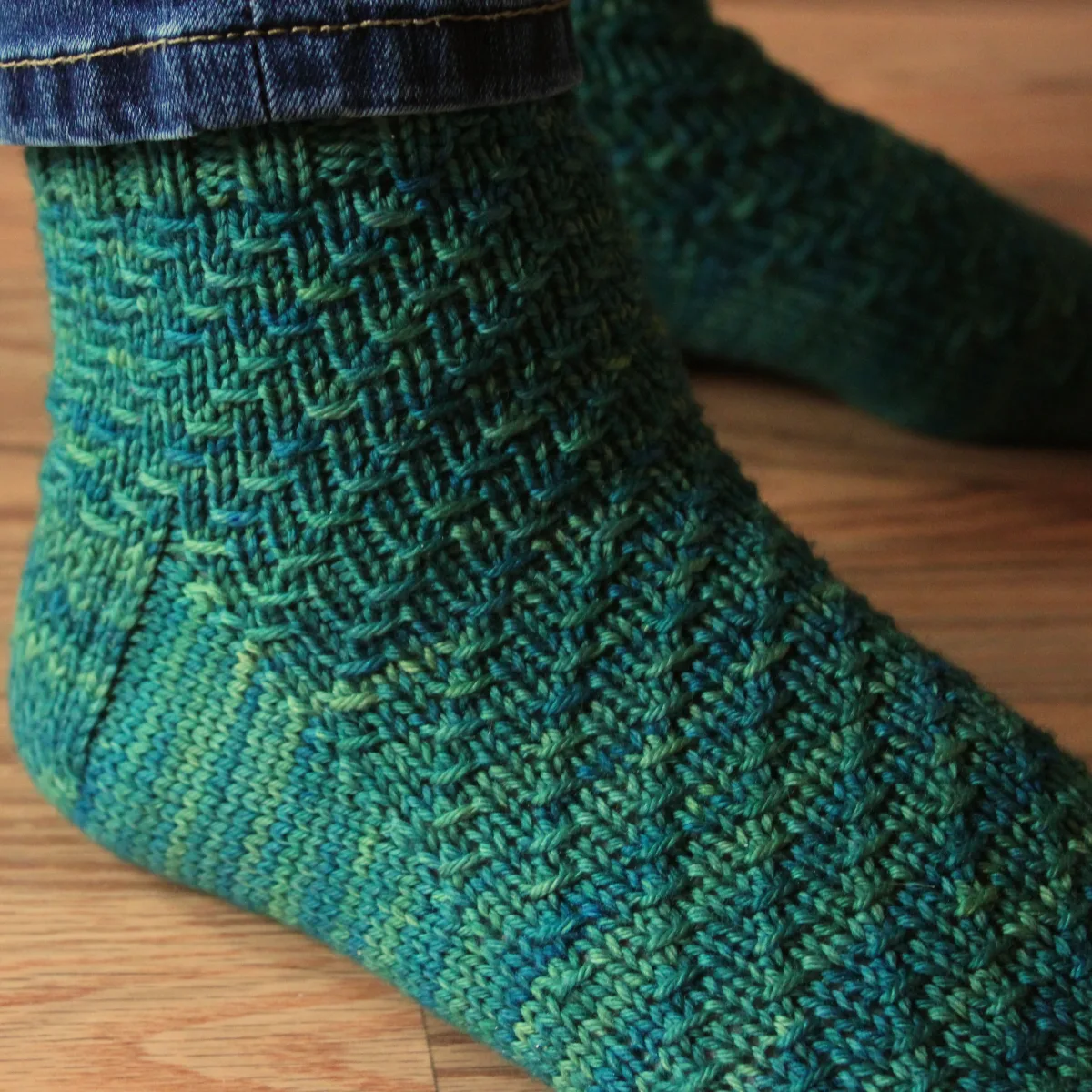
The Middle Ground: Two Circular Needles
Never heard of this method? You're not alone! Inevitably coming in last when you poll sock knitters on their favourite technique (because it's obscure, not because it's unloved!), in my opinion two circular needles deserves a lot more attention than it gets. It sits in an interesting place where it quietly solves some of the problems with the other methods without really calling much attention to itself (no marketable buzzwordy name, no needle companies rushing to sell specialty tools to accommodate it), and it's a really fantastic option to have in your knitting toolbox.
How Two Circulars Works
Like magic loop, for two circulars you divide your stitches in half. One half goes on one medium-length circular needle (either 40 cm / 16 inches or 60 cm / 24 inches is plenty of length; much more and you'll have a lot of excess dangling cord length to deal with), and the other half goes on the other medium-length circular needle. You use the empty side of the needle to knit the stitches on that same needle until you're finished that half, then you turn the project around and do the same on the other side. Each half is only worked by the circular needle it's already attached to; no pulling loops or juggling a loose working needle necessary. When you're not working a particular half of the stitches, they hang on the cable of their circular needle, stable and waiting for you to return to them. (There are some really good video tutorials on YouTube for this if you want to watch a demonstration of how it works.)
The main advantage to this method is that it takes the centrist position. It's almost as compact as magic loop but without some of its disadvantages, and it's almost as flexible as DPNs but without some of their disadvantages. Two circular needles means there are only two corners to turn, like magic loop, but because there's a needle break and not a continuous cord at the turns, there is less strain on those stitches at the turns and it's relatively easy to transfer stitches across the gaps when necessary. Two circulars can also hold lots of stitches on each circular needle, and they offer the option of two-at-a-time sock knitting (more on that later), just like magic loop. Using two different needle sizes is even easier on two circulars than it is on DPNs, and (as long as you're not moving it very far) it's almost as easy to move the BOR as it is on DPNs, too.
The main disadvantage of two circulars is that... it uses two circulars. You need to have two circular needles available in the same size (and often two pairs in at least two needle sizes, in order to have a smaller size for the cuff) to do it, which makes it the most expensive sock-knitting technique. The hanging-down needles from the circular needle waiting its turn while you work the opposite side might be less likely to drop their stitches than DPNs, but they definitely catch on the existing fabric more often and you still need to take some time to pull the cords and needles around a bit (though admittedly less than magic loop) when you turn to a new side. The flexible DPNs branded as "flexi-flips" (essentially DPNs attached in pairs with a short section of flexible cord between them) kind of live in a place in between DPNs and two circulars, and they reduce some of the issues that come with using two full-sized circular needles, but they are more akin to DPNs overall, and they are a specialty item that is only available from limited suppliers.
Choosing Sock Patterns For Two Circulars
Like magic loop, two circulars works best when the stitches in a sock pattern logically divide roughly in half. But this isn't as critical with two circulars; you only run into issues when there's a lot of back-and-forth across a needle gap, like wide short rows. A little bit of shifting one way or the other to accommodate cables, texture, or lace isn't a big deal. So even though two circulars is a relatively uncommon technique in discussions about sock knitting, it's almost as flexible as DPNs; most sock patterns you might want to make can be done on two circulars without any significant headaches.
Conclusion
Two circulars wins the award for "Most Balanced Sock-Knitting Method". While it isn't perfect, it's an excellent substitute for magic loop that's more flexible in what you can do at the turns (any pattern written specifically for magic loop will work for two circulars with no reinterpretation necessary), and a good substitute for DPNs that has fewer needle transitions and no loose needles to keep track of between knitting sessions. It's definitely worth investigating to see if it turns out that you'd like to join the low-key, unassuming two-circulars fan club!
Ideal For Two Circulars: If You Might Need Two Needle Sizes
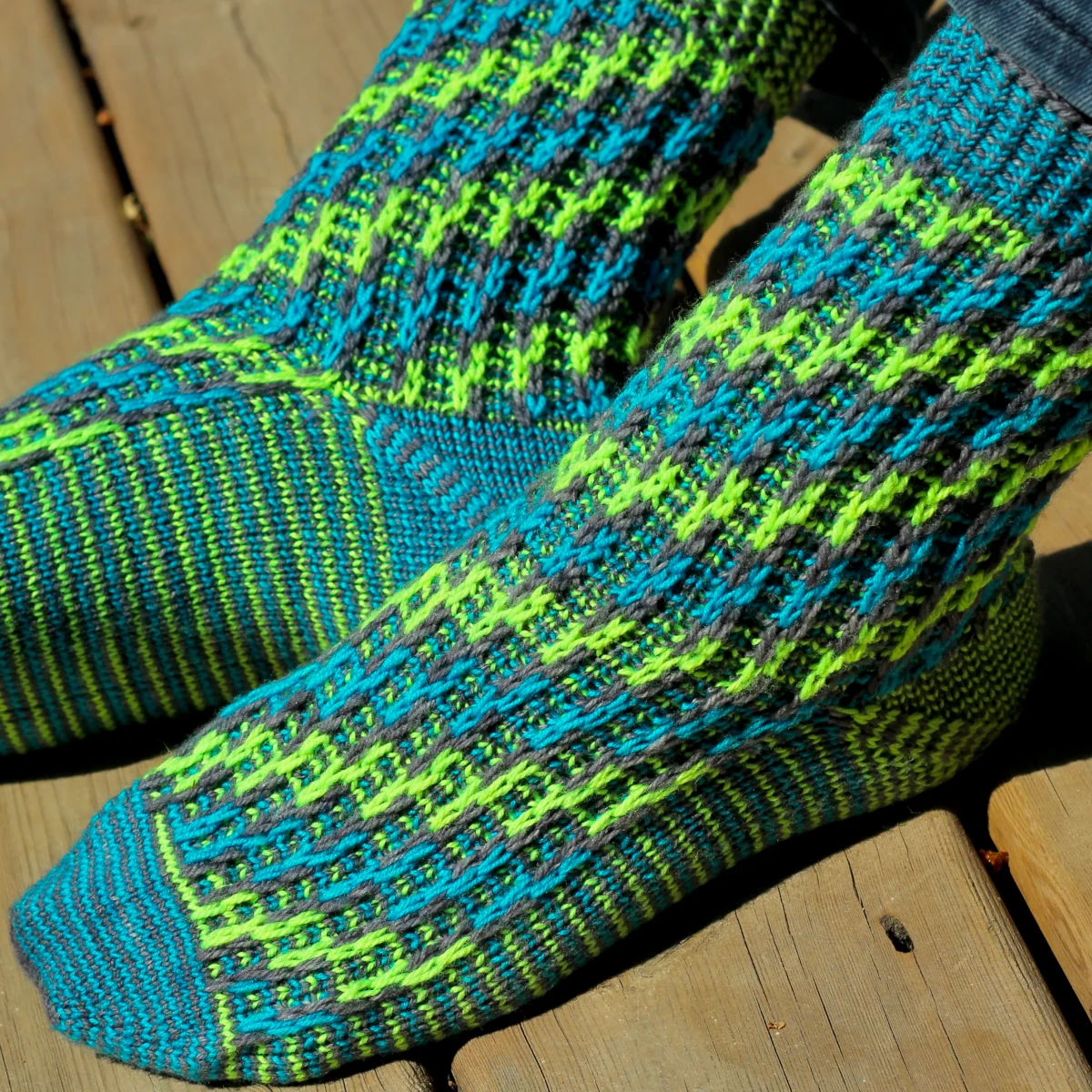
Not Ideal For Two Circulars: Wide Sections Of Short Rows
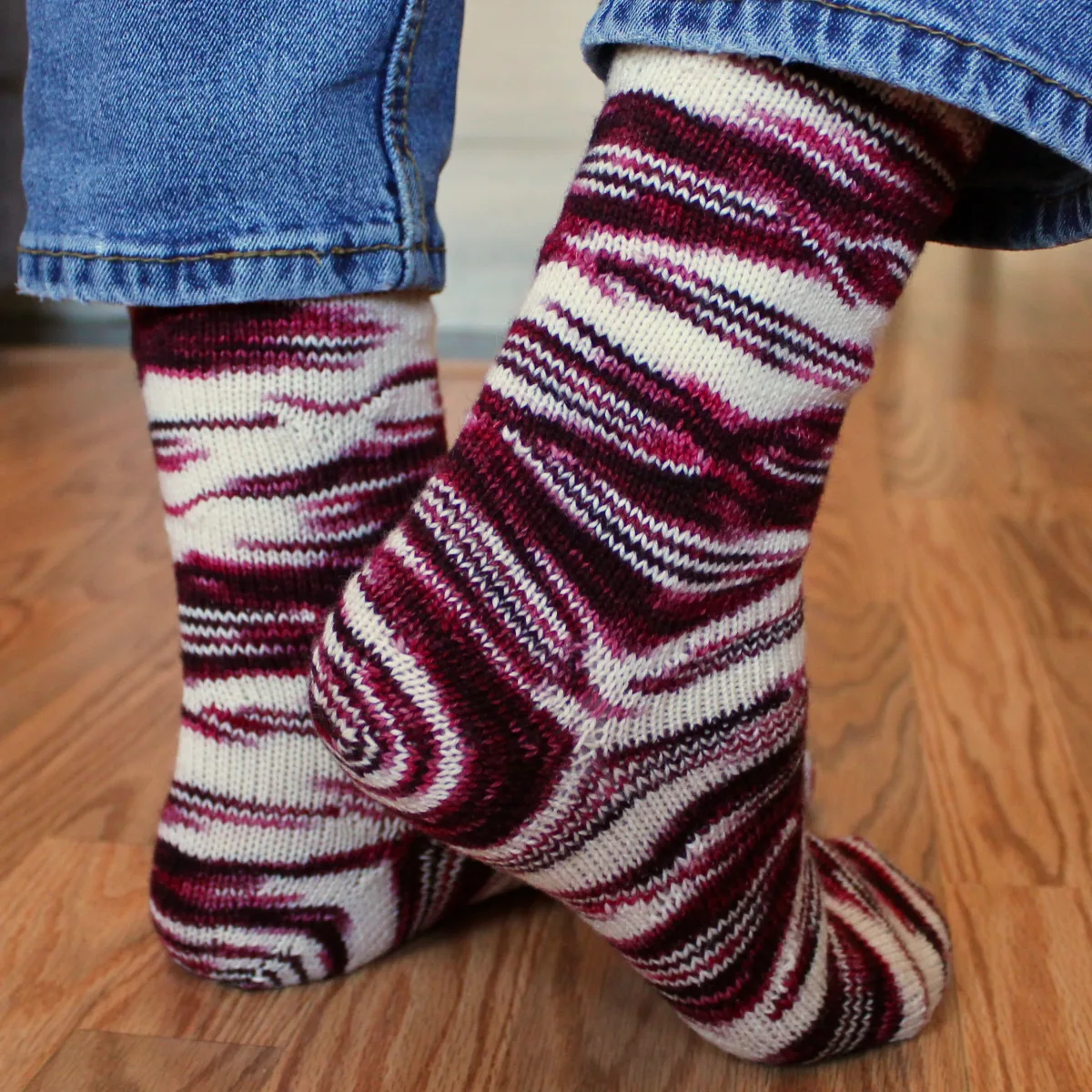
The Continuous Circle: Short Circular Needles
Ever wondered why you can't just make a sock the same way you make a hat, with one circular needle chosen at the right circumference and then working in smooth, break-free rounds? Well, you can! All you need is a 23 cm / 9 inch circular needle and a willingness to throw it away if it hurts you. Wait, "if it hurts you"?! Read on to find out what that means!
How Short Circulars Work
Short circular needles are used just like any other circular needles. You work in rounds, moving the stitches around the needles and the cable smoothly with no breaks. That's it! The only thing to remember is that it only works properly if the circumference of the knitting is nearly the same or greater than the circumference of the needles and cable. So really tiny-circumference socks (say, for a child or baby) won't work.
A big advantage to this method is that it's so simple. Needle breaks? What needle breaks? You never have to pull a long cord around or fiddle with a DPN. Because of this, it's arguably the fastest and most straightforward method of knitting socks. No learning curve at all; if you can already knit a hat, hypothetically you can knit a sock on a short circular needle. There's nothing new to learn in order to use this technique.
The main disadvantage of a short circular needle is that it's a bit of a gamble as to whether it will work for you or not. Some people try short circular needles and love them; other people try them and find them awkward or even painful to use. Because everything is on one cable, rearranging the stitches is a pain, even more so than magic loop, and some heel constructions are more difficult with no needle breaks available. Another issue is the sections of a sock that get narrow, like toes. You might need to briefly use DPNs, a second circular needle, or magic loop to manage those places, so the reality is that you will sometimes need to abandon the short circular needle for another small-circumference-knitting method (which sort of cancels out the short-circular-needle benefit of "no need to learn another method", because... it turns out that you still kind of do). One other disadvantage is that with no needle breaks, you'll need more stitch markers, especially if the pattern you're reading is technique-specific and likes to use the "Needle 1", "Needle 2", etc. style of pattern-writing (I do not do this, personally; all my sock patterns are method-neutral so if you need a marker, you'll know about it). But considering all the beautiful stitch markers out there, maybe this isn't such a big disadvantage...? Only a few needle companies offer this small of a circular-needle circumference, so that limits the range of materials the needles are made of and the availability and cost-effectiveness of this method, too.
Choosing Sock Patterns For Short Circulars
Short circular needles come with a lot of the same advantages in choosing a pattern as DPNs. With no turns or needle breaks to worry about, suddenly yarn overs, cables, and short rows have no impact on the logistics of knitting your sock. And, arguably, short circular needles are the best option for stranded colouwork, because it's much easier to get an even tension with no corners to deal with.
The only times when short circular needles will not work well is if you're making something with a construction that requires a lot of putting stitches aside for later and/or picking up stitches. If you have to put stitches on holders or distribute stitches you've picked up, DPNs are a lot easier to use for that purpose. And since the circumference is so small and knitting this way can be tough on your hands, patterns with a lot of high-tension techniques like cables might not be comfortable enough on a short circular needle, especially if you're making a smaller size and the stitches are stretched relatively far apart on the needle cord.
Conclusion
Short circular needles win the award for "Most Straightforward Sock-Knitting Method". It doesn't get simpler than "knit in the round on circular needles"! Even if you do have to occasionaly work parts of your sock with other methods (so, counterintuitively, it might not be ideal for beginner sock knitters), there's no more efficient and uncomplicated way to make a sock out there... as long as it doesn't hurt you.
Ideal For Short Circulars: Stranded Colourwork With Short-Row Heel

Not Ideal For Short Circulars: Unconventional Construction
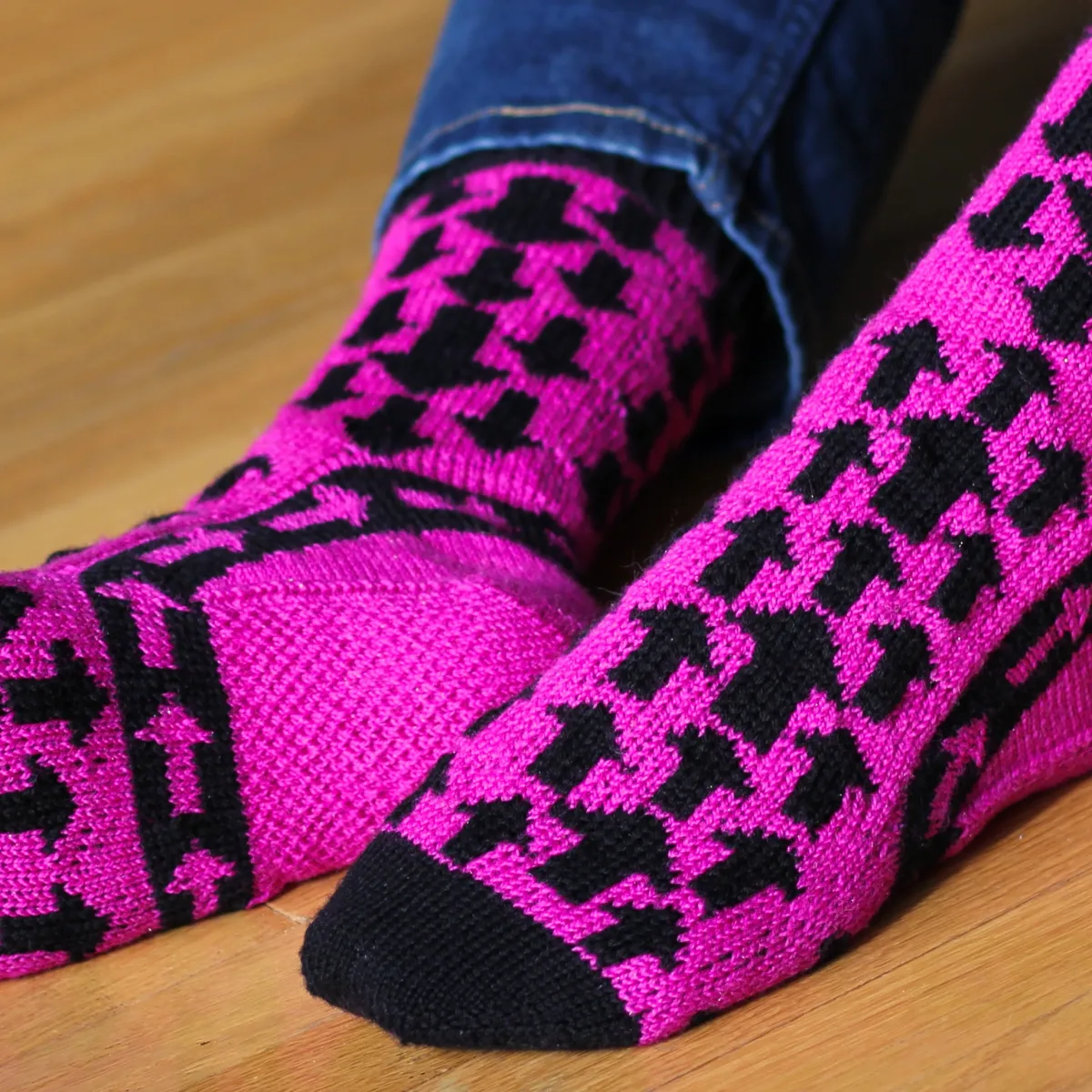
The Level-Up: Two-At-A-Time
Every once in a while, I ask someone what sock-knitting method they prefer, and they just say, "Two at a time." But there are actually at least two ways of working socks two-at-a-time (meaning, on the same needles and not working "tandem", where you have two socks on separate needles going at the same time). You can do so by adapting either of the sock-knitting techniques above that have lots of available space on the circular needle cords; i.e., magic loop or two circulars. The addition of the second sock does change some of the logistics of these methods, however, so although "two at a time" isn't a separate sock-knitting technique on its own, it's worth talking about the concept separately from one-at-a-time magic loop and two circulars techniques.
How Two-At-A-Time Works
Whether you're knitting on a single long-cable circular needle or on two medium-length circular needles, you still need to divide your stitches in half. The difference from working one-at-a-time is that there are two "first half" and two "second half" sections of stitches on each side of the setup. So, on magic loop, there are the same halves of two separate socks on the needle, and the other halves of the two socks are on the cable. For two circulars, each circular needle holds the same half of the sock for both socks. So as you work the foot, for example, you knit from one skein to work the sole of Sock 1, then from the other skein to work the sole of Sock 2, then you turn around to work the instep of Sock 2, then switch back to the first skein to work the instep of Sock 1. At each corner, you are continuing on the same sock, but in the middle of each side of the setup you are switching strands of yarn and which sock you're working. (You can see an example of how this works on magic loop in my video about Two-At-A-Time Afterthought Heels, and there are lots of beginner-level instructional videos online for both methods as well.)
The primary advantage of working two-at-a-time is purely psychological — it means that you don't have to finish one sock, then get motivated to do the entire thing again for the second sock. Some sock knitters struggle with "Second Sock Syndrome", where it just isn't enjoyable for them to redo the same sock twice to have a matching pair. So knitting both socks at the same time means no starting over and no loss of enthusiasm for the project that might delay finishing it. Logistically, working two-at-a-time also ensures you make your two socks exactly the same size in height and foot length (you don't have a choice, since due to the setup of the two socks on the needles you have to match each round on one sock with a round on the other sock), and, especially if you're working something complicated, it means that you work things like complex stitch patterns or tricky transitions at the same time, and you don't need to try to remember how to do it again on the second sock, days or weeks after you did it the first time. If you really hate keeping track of how many rounds you worked on the first sock so that the second one is the same, two-at-a-time completely eliminates the need to count rounds and take notes to size the sock and ensures that the two finished products match perfectly in size.
The main disadvantage of two-at-a-time is that it has all the same downsides as working one-at-a-time on magic loop or two circulars, but to an even more significant degree. For example, it can be annoying to shift stitches between halves on magic loop or two circulars, but if you're working one-at-a-time, it's absolutely doable. When working two-at-a-time, on one of the sides of each sock (specifically the ones in the middle of the work, where you transition between skeins), it's literally impossible to do it in place. You have to transfer one of the socks to a second set of needles or to a stitch holder/waste yarn, rearrange the stitches on both socks with them separated, and then transfer everything back to the single-set-of-needles setup again to keep working on them. This issue means that experience with sock construction and some advance planning are crucial to a successful two-at-a-time project — for example, when working toe-up socks with gussets, you need to make sure that all the gusset increases all happen on the half of the stitches where the heel turn will be, because otherwise half of them will not be accessible to you when you need to attach the gusset stitches to the heel flap later (at least, not without separating the socks and significantly readjusting the setup of the stitches). Plus, you have the yarn management issue of having to keep two strands separate from each other throughout the project (though you can work from both ends of the skein, that only works for single-yarn socks and it's often tidier if you divide the yarn in half and cut it apart), avoiding both tangles and accidentally attaching the two socks together by forgetting to switch skeins at the break between socks.
Choosing Sock Patterns For Two-At-A-Time
As you can see from the above, a stable BOR and halfway point is very important for working two-at-a-time, even more so than for one-at-a-time on magic loop or two circulars. For the same logistical reason as shifting stitches, there are also going to be problems with patterning and shaping in some patterns. Picking up stitches, plus working yarn overs, lifted increases, decreases, short rows, or horizontally-travelling stitches like cables in those middle corners are all either very awkward or in some cases literally impossible without separating the two socks. So spiralling patterning or all-over lace is extremely inconvenient, to say the least, when working two-at-a-time. Patterns with mirrored motifs might also be more complicated, since you need to follow two charts/sets of instructions at once and keep straight which sock is which as you work. Because you always have twice as many strands going at once when working two-at-a-time, you also might find it inconvenient to deal with patterns with multiple strands of yarn on each sock when using this technique.
Essentially, the best candidates for two-at-a-time socks are relatively-plain patterns. Vanilla socks and many nearly-vanilla socks work great with this method, and patterns worked in a single colour with patterning that runs vertically (not in textured spirals) with a consistent break point between front and back are also an option. Socks made with self-striping yarn are a particular favourite for two-at-a-time enthusiasts, because the characteristic of having the exact same number of rounds in both socks means that the stripes are likely to be a nearly-perfect match.
Conclusion
Two-at-a-time wins the award for "Most Impressive-Looking Sock-Knitting Method". Although it's definitely complex-looking to people watching you work on a two-at-a-time project, it's easier than it looks, and for some patterns (and some sections of patterns, like afterthought heels), it's a great way to avoid "Second Sock Syndrome" and have an enjoyable experience making your perfectly-matching socks. While I don't love it for designing (after all, working two at a time means twice as much to frog when things need tweaking!), it's popular for a reason, and honestly? When you do it, it looks so cool and expert-like that you kind of feel like a sock-knitting magician!
Ideal For Two-At-A-Time: Nearly-Vanilla Self-Striping Socks
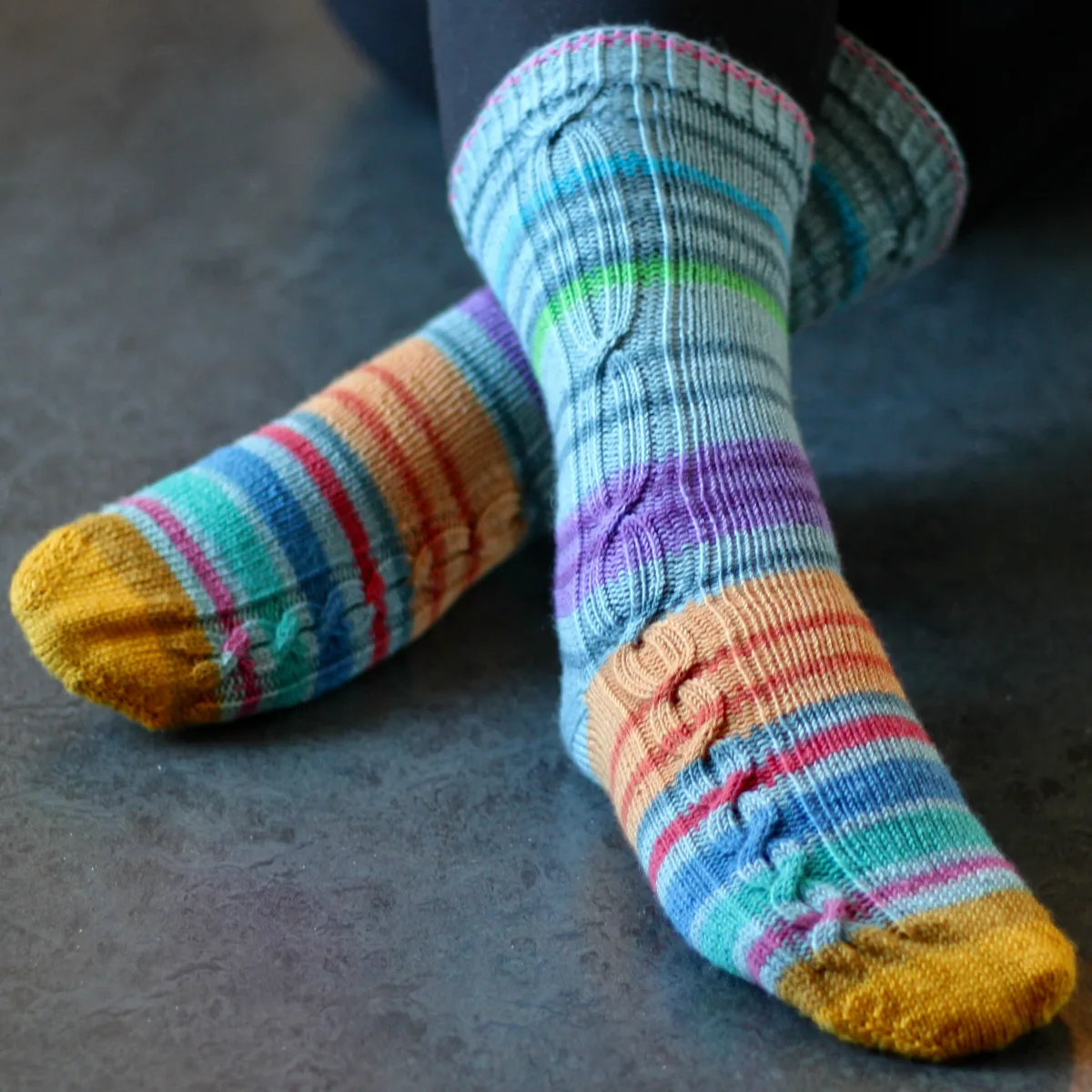
Not Ideal For Two-At-A-Time: Mirrored Spiralling Cable Patterning

Of course, as sock knitters we're all going to have our favourite techniques for making those small-circumference circles that socks require! But think about enjoying the freedom of having lots of tools in your back pocket for all the lovely patterns you might want to make, instead of getting frustrated if a design isn't perfect for your number one choice of method. While lots of patterns will work well with any sock-knitting method, not every beautiful sock is going to have a stable halfway point, or never move the BOR, or only place yarn overs or cables in convenient middle-of-a-needle locations. But if you can use more than one sock-knitting technique with confidence, you can enjoy your project no matter what logstical quirks might be required to make it work.






